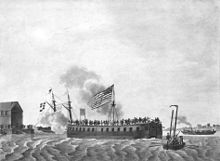Floating battery
The floating battery is an obsolete type of warship that was used to support coastal land-based military operations or to defend one's own coastline.
For floating batteries , decommissioned and obsolete ships, unfinished hulls, pontoons and other large floating bodies or special new buildings were used. Most of them had little or no drive of their own and were often dragged to the scene.
Floating batteries were used, among other things, for bombardment during the siege of coastal fortresses (e.g. in the Crimean War ) or for bombarding enemy positions near the coast. Floating batteries were also used to protect their own coastline or their own coastal cities and naval bases. They were then mostly firmly anchored.
The floating batteries were mostly armed with outdated large-caliber guns of various designs up to field guns.
With the change in strategy and tactics in modern 20th century warfare, floating batteries were no longer needed. Their tasks were taken over by other types of warship ( battleships , cruisers , destroyers ).
Great Britain used ocean-going monitors for coastal bombardment during the First and Second World Wars . Floating batteries experienced a renaissance in the Second World War when reinforcing air defense. Floating flak batteries equipped with anti-aircraft guns were used by the warring parties to protect against enemy air attacks in the coastal area.
Floating batteries
- Demologos (U.S., 1815)
- Arrogante (France, 1855)
- San Giorgio (Italy, formerly armored cruiser, 1908)
- Before Friedrichshafen (1943–1945)

